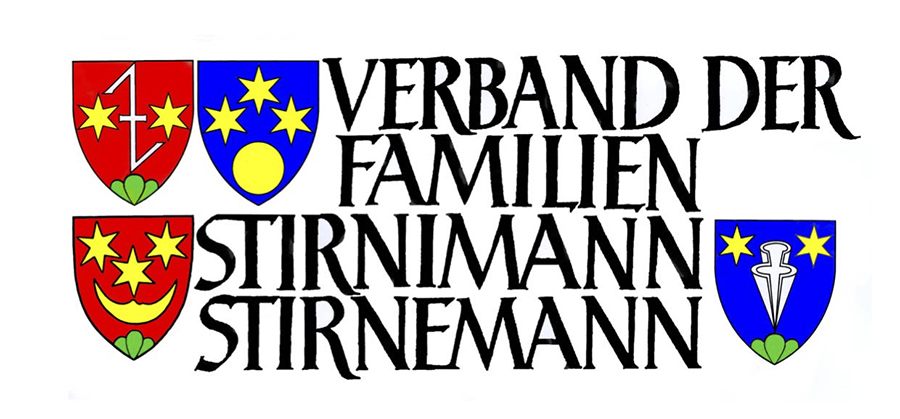

Newsletter No. 50 Lucern - January 2024
www.stirnimann-stirnemann.ch verband.stirnimann.stirnemann@gmail.com
Table of contents
Greetings
50 years of association history
Statistics, Indiana not India
A founding member tells
Family research in large format
Invitation anniversary event, contact
Please note the invitation to Anniversary event on page 11 as well as the enclosed flyer!
From the bottom of my heart I wish everyone good and happy New Year, joy and health to you and your loved ones, wishes on behalf of you of the board, your president Moritz Stirnimann
You already notice, my dear relatives, nearer and farther and valued members and friends of our family association, At this point I would like to look forward to the newsletter and optimistic for 2024 remain.
The problems facing humanity Towers have grown large and are threatening to crush us. How to counteract this on a small scale? Only by committing ourselves to everything Despite life, rejoice and this joy carry outside. May your joy be others infect.
There is also joy in the association! He celebrate its 50th anniversary on September 6, 2024. Reason for a family reunion, that we had to do without for long enough. The board is looking forward to Wyher Castle She!
50 years of association of families
Stirnimann-Stirnemann- Sternenman-Sternaman
A hike through 50 newsletters
The first steps
“It actually started romantically. Captured in 1969 a hit from Switzerland within a short time time the world. He had one for us flattering name: “Grüezi wohl, Frau Stirnimaa.“ ” The singing trio of this hit, it had the medieval name “The Minstrels,” Stirnimann invited all the women from Switzerland to a meeting in Lucerne.
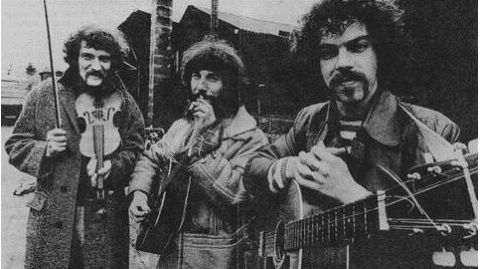
This idea sparked Anton Stirnimann from Lucerne, our first cashier. So he quickly contacted Professor Joseph Stirnimann with the idea of a family reunion. What followed was the logical consequence of ripe fruit, writes President Josef Stirnimann-Haas in Newsletter No. 11 (1985)
The story made people sit up and take notice: “Stirnimann conference, a remarkable occasion” wrote the “Anzeiger vom Rottal” on September 11, 1970 and the “Luzerner Tagblatt” headlined on September 15, 1970: “A major rally by Stirnimann”. And on September 6, 1970, well over 200 namesakes actually met at the Gasthof Eintracht in Rüediswil. The author recognizes the centrifugal forces in the world of the 1970s that are tearing everything apart and counters these with the power of “clan solidarity”. But that alone wasn't enough: the feast day began with a holy mass in the Ruswil parish church, celebrated by Prof. Dr. Joseph Stirnimann. People prayed for divine assistance. In Rüediswil, the decorated Eintrachtsaal awaited the guests. The mayor gave a eulogy to those gathered, the local music played, and a yodelling duo sang. Prof. Joseph Stirnimann presented his research work to the family for the first time.
In newsletter No. 11, the then president continues to remember the initiative committee that got everything rolling: He names the names to whom we owe the existence of our association: Anton Stirnimann–Schöb, Lucerne; Franz-Xaver Stirnimann-Seiler, Horw; Hans Stirnimann-Haupt, Ruswil; Josef Stirnimann-Haas, Ruswil; Josef Stirnimann-Wälchli, Eintracht Rüediswil; Dr. Prof. Joseph Stirnimann, Lucerne; Kaspar Stirnimann-Müller, Sursee.
The course has been set: nothing stands in the way of founding the association. The "Fatherland" of January 28, 1971 reports under the title "The Stirnimann family, a 600-year-old family" from the professor's lecture at an event organized by the Swiss Society for Family Research in the Hotel Union in Lucerne.
The association was founded in 1974
On September 8, 1974, the founding meeting was held in the hall of the parish hall in Ruswil. 180 people came together and agreed to found the association. The statutes were discussed and a first board of directors was appointed. The professor talks about the meaning and purpose of the association. The concern of 1970 is formulated again: community spirit, cohesion, support and protection against the threat and disintegration in the world (see circular no. 1).
This is a remarkable statement from the Founders, especially since the same words could be spoken by ourselves 50 years later. Here we stumble upon a phenomenon that I would like to describe as a continuum of pessimistic world experience. Every generation seems to be dissatisfied with the state of the world in which they live. I would like to give you, without comment, G.W. To counter Leibnitz: The world as it is, is the best of all worlds, he wrote in 1710.
After the meeting, the Ruswil Stirnimann ancestral homesteads will be visited and a memorial linden tree will be planted at the Etzenerlen schoolhouse. A sign that, according to Leibnitz, should radiate optimism into the future.
The years of family research 1974-2001
The years from its founding in 1974 until the resignation of Vice President Prof. Joseph Stirnimann are marked by his publications on the history of the family. The results of his research work, published in the newsletters, are his real legacy to those who live afterward.
In 1984, a report in the newsletter about the Brandenburg community of Storbeck caused a stir. Heinz Stirnemann, descendant of Bernese emigrants to Mark-Brandenburg, presented his family history and genealogy. The family reunion in Ruswil (September 9th, 1984) acquired an international character, as guests came from Brandenburg and Alsace. Friendships for life are created.
In 1989, the publication focused on one of our main houses: the house “Unter Rot”, restored true to the original, shines in new splendor. The house is a jewel in the Lucerne landscape.
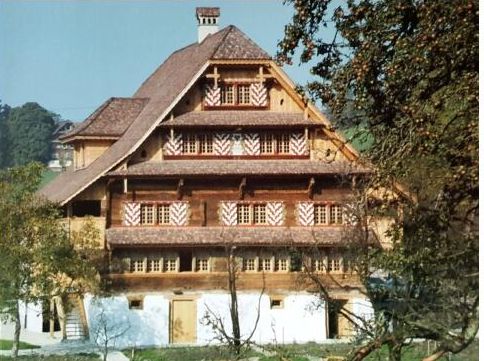
Image: The house “Under Rot”
In 1994 the association celebrated its 20th anniversary. The family conference will take place at Wyher Castle in Ettiswil. In circular 20, Joseph Stirnimann writes a two-page review of what has been achieved: He names the central pillars of the association's work as the sense of family and community that is lived out in the family conferences and the circulars that keep alive and document the memory of the family history.
This year the first trips have been documented. President Joseph Stirnimann travels with his family to the Stirnemanns in Colmar and Storbeck in Brandenburg.
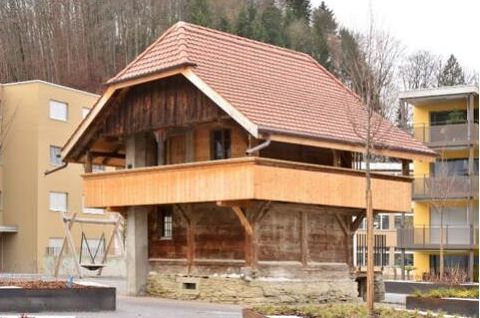
Image: Old warehouse on Lochgasse in Gränichen
In 1995, newsletter 21 looked at the Stirnemann family branch from the Aargau.
These contributions are due to Georges Stirnemann (member since 1984) from Colmar, who worked intensively to clarify the Stirnemann genealogy. As a result, in 1996 there was a family reunion in Kaysersberg, Alsace. The presidency also changes here: Josef Stirnimann is resigning from the presidency after 19 years. His successor is Beat Stirnimann, from Ruswil, who was a primary school teacher in Uffikon at the time. In 1999 they met in Gränichen.
Storbeck once again becomes the focus of interest. The little church that Swiss immigrants built around 1700 needs to be renovated. The small community lacks financial resources. The association and others were able to help: around 49,000 marks in Swiss donations flowed to Brandenburg through fundraising.
The 1998 newsletter published a letter from the USA that reached us on February 5, 1998. The descendants of Swiss emigrants contact us and ask for help with genealogical questions. Our association now has members called Sterneman; Walt Sterneman presents his family history in Newsletter 26.
In newsletters 25, 26 and 27 the professor deals with the topic of the religious who come from our family and who dedicated their lives to a Christian community. The church played an important role for the Catholic Stirnimanns for a long time. With this view of the “praying stand,” our association ship passed the millennium mark. Beat Stirnimann talks about change in his introduction: “Every person [changes] consciously or unconsciously during their life […].” This is a “law of life.” This is how he tells the reader that Professor Joseph Stirnimann is from withdrew to the board. A drastic event for family research.
Change from another side: Since 2000, the association's website has been called “www.stirnimann-stirnemann.ch”.
2002 – 2023; Years of consolidation
The 2002 newsletter begins the diary cycle of Father Jodok (Jost Stirni-mann), who lived and worked in the Benedictine Muri Abbey. Thanks to this surviving diary, the reader gets a rare glimpse into the cloister of a baroque monastery, i.e. into the closed world of the monks and the people around the monastery.
The association presents two publications: the “Collection of Circulars 1974-2000” and the “Keywords and List of Names for the Circulars”. A must for every Stirnimann-Stirnemann researcher.
The newsletter is changing. Personal portraits of living Stirnimänn/Stirnemänn show how our family contributes to society. In association life, family conferences are connecting occasions for people to meet.
Joseph Stirnimann died on October 9, 2004. He leaves us a number of notes in the newsletters, his chronicle “The Stirnimann family in the cantons of Lucerne and Aargau” from 1973. With his death, his unpublished notes (if there were any) disappear from family history. His theological work and letters are stored under lock and key in the Lucerne State Archives. The archivist couldn't find anything about the family history. Inquiries to various archives in Lucerne and the Canons' Monastery of St. Leodegar, Lucerne, were answered negatively. We are left with the personal family trees he created, of which the association only knows a few.
The 2014 newsletter publishes the research results of Georges Stirnemann about Stirnemann in Berlin. In doing so, he unintentionally activates the gang to Brandenburg, where a group of Stirnimann men and women set off in May 2015. The family bonds remain strong even after many years; We receive a warm welcome and spend wonderful hours in Storbeck with the Stirnemanns from Storbeck. Opportunity to visit the graves and visit the little church. There is a lot to report.
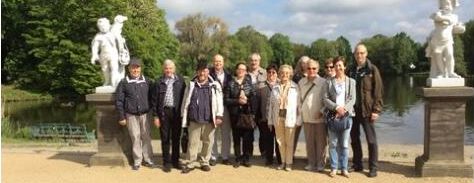
Image: Tour group in the Charlottenburg Palace Park
In May 2017 the association is back on track. This time the route takes us to Colmar, where Georges Stirnemann awaits us and guides us knowledgeably through Colmar, Sélestat and Haut-Königsbourg. For Beat Stirnimann, our president, everything has come full circle. He was elected in Alsace, and the Alsace trip is his last official act.
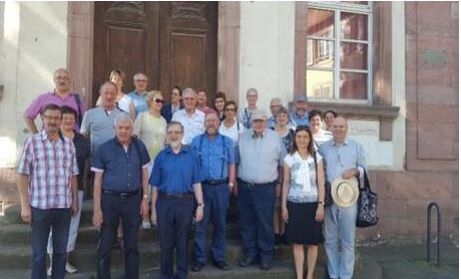
Image: Tour group in Colmar
In Newsletter 44 he says goodbye after 20 years. At the family meeting in Muri, he passes the baton to his cousin Moritz Stirnimann. Muri is the center of activity of the Benedictine Father Jodok, to whom we also pay homage with a tour of the monastery rooms and the organ concert in the church. The conference in Muri is a conference of farewell. Veteran women and men are leaving the board after many years: Beat Stirnimann, Franz Stirnimann, Agnes Bensegger-Stirnimann and Fritz Stirnemann are stepping down.
The board is becoming smaller, also a sign of the times; Club work requires a certain amount of community spirit.
In September 2019, an Autocar drives to Freiburgerland. The association trip takes us to Posieux, where Jean-Pierre Stirnimann and his brother Bruno run a large agricultural business. An impressive excursion.
In the same year we received a request from Joanne Sternaman from the USA. This query makes it clear that European immigrants with the name Stirnemann or Stirnimann suddenly have surnames that sound completely different to us. Our association includes the name Sternaman as the fourth equivalent on the homepage.
Who would have thought in the fall of 2019 that our entire lives would be curtailed in the drastic way that happened in the Corona crisis. The newsletter is dedicated to this topic: members from different parts of the world report on how their families are getting through the crisis.
With the 2022 newsletter, the association is focusing on a more family-related topic. Heraldry (heraldry). It's surprising: so many family branches, so many coats of arms.
It is September 16, 2022, a Saturday afternoon, when a group of brave people gathered at the Moritzli in Ruswil to listen to Werner Wandeler's “Rusmeler Stories”. Ruswil is no stranger to the Swiss historical landscape, even if it has a bit of a conservative air about it. In any case, the visitors were happy about the expert lecture and the togetherness.
What began with the first website continues to become the focus of the board's work. The homepage should be updated and useful information stored digitally. The electronic addresses (e-mail) of the members are recorded.
The 2023 newsletter focuses on research work by George Stirnemann from Colmar about the piano maker Jean-Jacques Stirnemann.
This is where my little review of the newsletters that document 50 years of association life ends. These 50 years have been possible because of you, dear readers, who as members support what we do and give it meaning. These 50 years were made possible through the personal commitment of individuals on the board. As president of the association, I would like to express my heartfelt thanks to everyone!
Statistics
The statistics on surnames (surnames) from the Federal Statistical Office show over half a million surnames in Switzerland. Different spellings were counted separately.
In 2021, 1,349 people lived in Switzerland as bearers of the Stirnimann surname, and 528 Stirnemann. The largest clan was that of the Müller with around 53,000 people (source: Federal Statistical Office).
Indiana is not India
Issues with addresses not being updated
Unfortunately, it is a fact of association in the 21st century: changes of address are only rarely communicated to the association by members. So we lose valid addresses, ultimately members, every year. We can no longer rely on “postmen” like we used to, who often documented moves with the new address. “Address unknown” and “recipient unknown” are written on the returns. So this year I went out into the Lucerne countryside myself to visit a farm and find out where this member had moved to. A neighbor was able to give me information that I wouldn't have gotten from the post office: data protection!
A letter that landed back with me on September 8th, 2023 after eight months of travel was different. “Missing to India” was written on it. This made it clear: our association member in Indiana, USA, did not receive the 2023 newsletter. The country code USA was forgotten during shipping, so the post office did not send the letter to Indiana, but to India. The Indian Post has realized what one can no longer expect from the digitalized Swiss mail: Indiana and India are not the same. (most)
A founding member tells us
Josef Stirnimann-Haas (*1943)
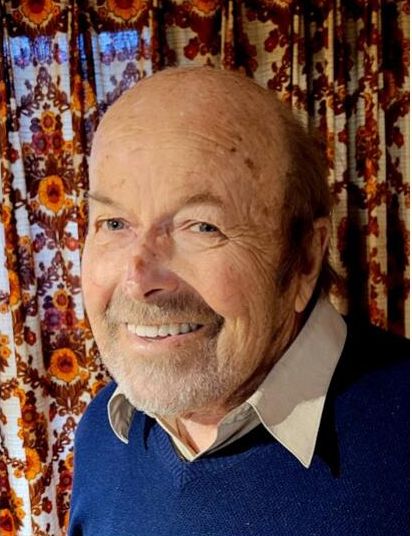
Josef, now 80 years old, grew up on the “Strick”, a large farm on the Ruswilerberg. He remembers his long walk to the village schoolhouse, which he and his six siblings had to walk every day, in sun, rain, wind and cold. “And 4 kilometers on foot is a long way. As the eldest son of a farmer, I learned to be a farmer as usual. But that wasn't my passion, so as a trained and qualified farmer, I began training to become a primary teacher at the age of 25. There was a shortage of teachers at the time, so the teacher training course was shortened and the missing unit was converted into a practical assignment lasting 6 months. So I came to Rohrmatt for six months, at that time a comprehensive school with 33 students, 4th, 5th and 6th graders. The young man used the summer holidays to travel. He talks about the USA and Canada, about the vast and endless landscapes. All it took was a little and he would have stayed. Another year, probably 1974, he traveled overland to India. He talks about Iran and Afghanistan, which left an impression for life. Two more trips followed: to East Africa and to China and Vietnam.
He and his wife would have liked to build something on their parents' farm, but since no more land was allowed there, they were able to buy the house in “Sonnebergli” in 1976. So the house hasn't belonged to the Stirnimanns since ancient times. After all, the client's wife was a native of our family. I was happy when I found an engraving with the name Gut-Stirnimann while renovating.
Josef is the father of two daughters and the proud grandfather of six grandchildren. Both daughters studied and had children relatively late. “And I enjoy my grandchildren and my daughters, where you can really feel the joy of being a mother.” And beams!
Joseph looks back on a rich life. As a secondary school teacher in Ruswil, he has many warm memories of his students, who also gave him a lot: whoever gives, gets often something back, is one of his mottos. Gifted with a talent for music, a school class grew into a student choir, which became a youth band. Josef helped to found the local music school, played the clarinet in the village band and made dance music with the accordion for many years.
Listening to yourself, learning to listen to your body, is a man's second guiding principle. He goes through illnesses in his life and deals with diagnoses and therapies. He consults with doctors and realizes “that not every therapy is just good. I gave up what wasn't good for me and looked for something else." "I freed myself from fears. That's why I tackle things with the belief that it will all work out in the end. You know,” he says, “politics, religion and medicine have a tendency to scare people. But fears are bad advisors!” He is also helped by a deep conviction that things will turn out well. “Yes,” I say, “we can do no more than die.” And Josef: “Yes, dying is a wonderful thing.”
In Ruswil he was president of the local CVP for some time. He doesn't like the power games; it's about the concerns of the people in the community. He has an open attitude and thinks today: we have achieved a lot of good things for Ruswil.
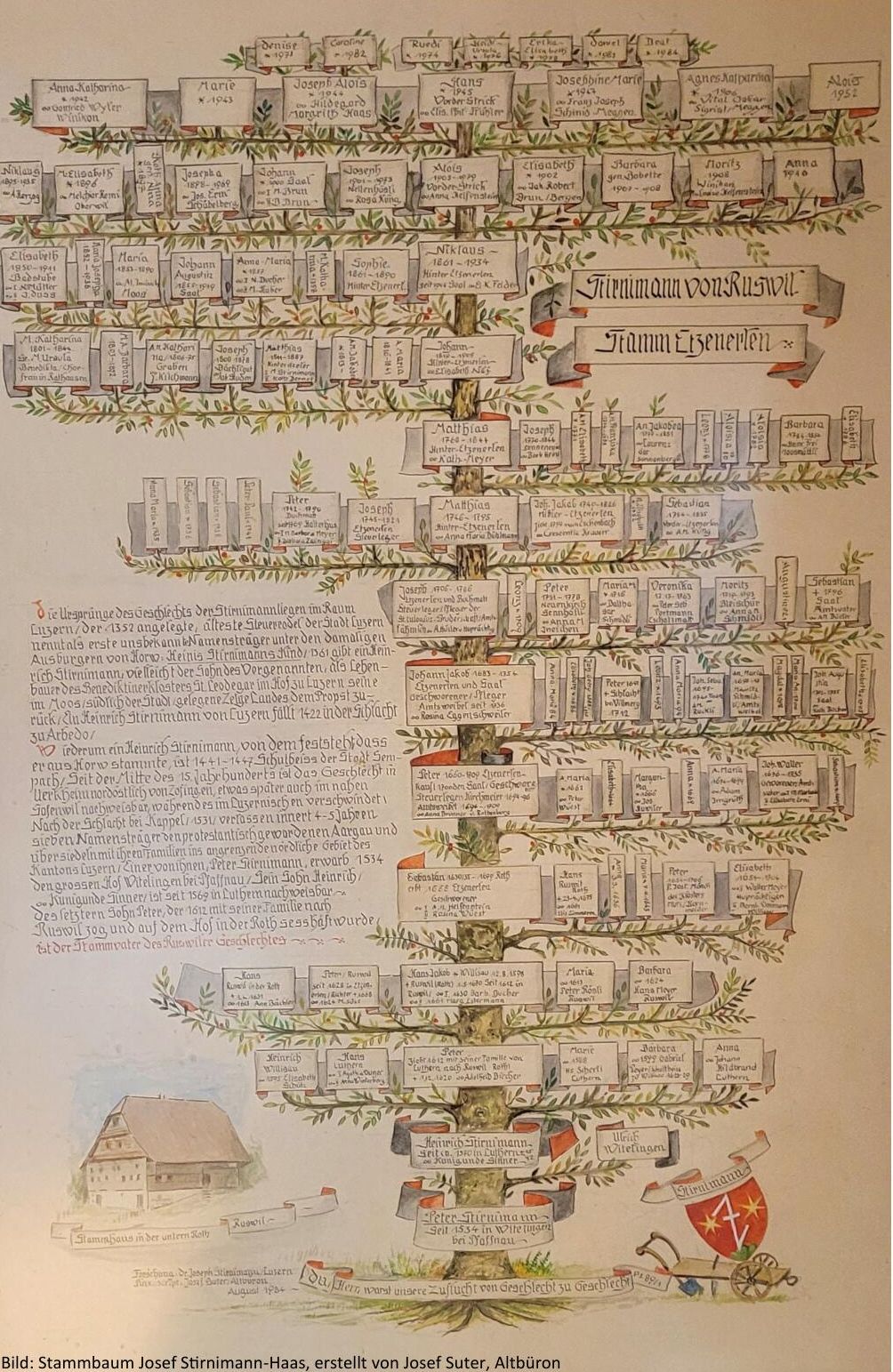
At 60, he gave up teaching. He dedicates his work to his gift, “spirit healing” and laying on of hands. Josef is a qualified alternative practitioner; his fourth job. Medially connected to masters of the spiritual world, he helps many people in their needs. “People of all kinds have come to me: CEOs, psychiatrists, musicians, women, men.” He was able to help many and advise many. “I didn't have any tariffs, rich and poor alike need help, and everyone gives what they can. Just put something in the mailbox!” - And there was always something there that we had to live with.
Then let's talk about the family association. “If you look back on 50 years of family association, what is important to you?” “It is still important that it exists! “Look” - and he starts talking bubblingly. “The first conference at Eintracht in Rüediswil was an incredible event. And a lot has happened since then. – But the association is a structure that gives the family a place, a memory, a memory and one should continue to work on it”.
Research into the Stirnimann family was initiated by Pastor Gassmann. He started it. His papers are then in the hands of Dr. Joseph Stirnimann, the “professor”, who found out a lot. In the course of his research, he also found a box of old division books in the community archives and the scribe said: “Do whatever you want with the old junk!” Reading these books gave rise to his wealth of knowledge about the farms, the divisions and sales. – “I don’t have to worry about the loss of the professor’s archive,” says Joseph: “You know, when I was with the professor, he often came with a stack of loose sheets of paper. He rummaged through it and found some note, some small detail. I never made sense of these sheets! The same will happen to his executors!”
“The writing about the Stirnimann families was supported by the Swiss Society for Family Research. It came out before the association was founded. By the way, with massive misprints. Many copies had either completely white or completely black pages inside. That was a bit embarrassing. The buyers complained and we ordered a reprint and organized a large exchange campaign.”
“At the first meeting in 1974, the issue of the association’s executive committee was also discussed. It was apparently very important to the professor here to have a president who was close to the church. So Hans Stirnimann-Haupt, president of the Ruswil church council, was proposed as the first president. I became deputy and took his place in May 1977. In September 1996 I handed over to Beat Stirnimann. Heidi Stirnimann from Stansstad was also on the board. She worked for the canton and was able to print the first newsletters inexpensively. Hospital cashier Anton Stirnimann became cashier. He had a large budget under his belt at work, so nothing could go wrong." - By the way: and he changes the subject: "The lime tree that we planted on the Etzenerlen schoolhouse square no longer exists. The farmers up there couldn't really enjoy this young symbol; she died miserably.”
When it comes to the relationship between Stirnimann and Stirnemann, Josef notes a cultural difference: The Reformation, the separation of the church in Switzerland in the early 16th century, had already left its mark. And we attribute the two name variants (whether rightly or wrongly) to these events. However, we agree that the association has overcome the denominational question and we see ourselves as a unit: True to the motto of the homepage:
Four name variations, one family
Stirnimann-Stirnemann- Sternenman-Sternaman
Family research on a large scale
Andreas Stirnemann, Gränichen
The email reaches me on August 26, 2023: “In connection with the family ancestry, I could provide you with our family tree (from 1576). Data security would of course have to be maintained. I started developing the family tree together with my father in 1996. The last revision was in 2017. The information comes from the church register and community list of the municipality of Gränichen”.
The messages go back and forth. I am aware of the problem of the personal rights of living people and so is Andreas Stirnemann. He remains reserved, cautious. I then asked him about a portrait in the newsletter: I try to give equal weight to both branches of the family in the newsletter and for this newsletter I have decided to introduce one person each. I am also very aware that I am not introducing any women again, although this year I also had encounters with women who asked the association about family history. I vow to get better!
St. Nicholas Day 2023, Gränichen. I'm standing in front of a modern single-family house, cube-shaped, large windows, wooden facade. A tall, slim man, well-groomed and wearing glasses, greets me at the door: Andreas Stirnemann. We quickly start talking; he has prepared himself. We talk about the community in which he grew up and now lives again, about biography, about family trees, Family and family stories.
But first he rolls out what he described to me in the August email as a lineage. 7 meters long, 60 cm wide, with an estimated 250 boxes; one for each ancestor or relative. His father had already created a draft on an A4 sheet of paper with all the progenitors from 1576 onwards. Then in 1996 they went to the municipality's archives and later obtained a permit from the canton to be able to inspect the personal registers. “As a community forester, father knew the “administration” well and, more importantly, he could read the old Sütterlin script.”
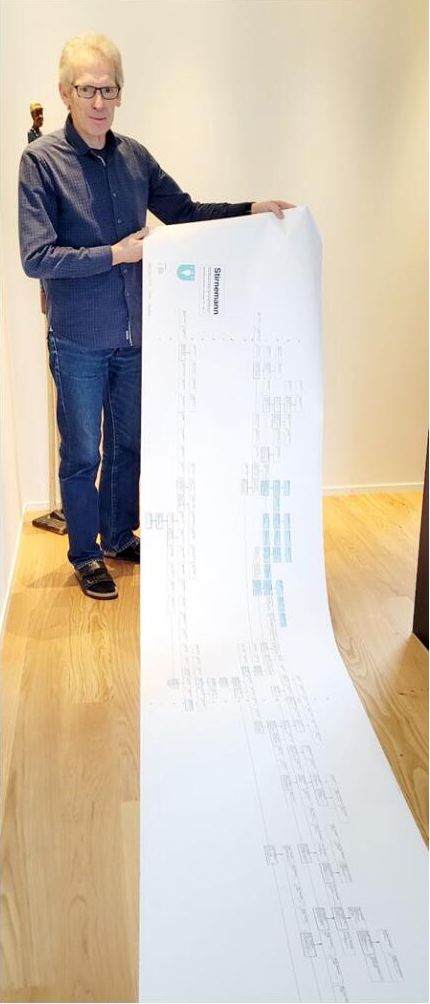
Image: Andreas Stirnemann and his work
“Without him I would have been lost!” Various designs were created in the architecture office using the drawing program on his computer. Gradually we got the hang of the best representation! But such a family tree never ends as long as there are descendants.
He is professionally an architect, trained at the Brugg-Windisch University of Applied Sciences. The father of three adult children, two boys and one girl, grew up in Gränichen but left early. He lived in Wohlen AG, where his wife comes from, for 30 years and his children also grew up there.
Andreas has been involved in sports his whole life: first football and skiing, then later running, cross-country skiing and cycling. He ran the marathon distance nine times, including in New York, Berlin and London. Today he lives on the property that he was able to take over from his parents and on which he built a new building above the existing basement in 2022. His paternal grandfather originally came from Gränichen, from where he moved to Muhen and lived on a farm there. His father returned to Gränichen in 1966 with the family and as a community forester. Some of his closer relatives still live in Muhen via his mother's line. “Mother was a Keppler,” and actually related to the famous physicist and celestial explorer Johannes Kepler (1571-1630). “Your great-grandfather, my great-great-grandfather on my mother’s side, immigrated from Germany to Switzerland and was naturalized in Muhen in 1831.”
Gränichen itself is one of the larger municipalities in the canton of Aargau in terms of area. It has a lot of forest (990 hectares), “work enough for father”, is more rural and currently has around 8,700 inhabitants. The proximity to Aarau makes the village attractive as a place to live.
Gränichen also advertises with the slogan: “A village to be at home!” So how do the Stirnemanns get to Gränichen? Circular 1995 No. 21 attempts to answer the question. It is believed that military operations around Aargau (around 1415) brought mercenaries from Lucerne to the area. Among these a few Stirnemanns. Andreas and I lean over maps, marvel at the distances, look for Safenwil and Uerkheim, then St. Urban, because Peter, who bought the Witelingen farm in 1534, probably came from Aargau. If all of this is true, he would have been something like a “late returnee.”
I am impressed by Andreas' research work. I am pleased that we are allowed to store this large representation digitally in our archive, provided that living persons remain protected. It should also be noted that Andrea's son Eric subsequently implemented a similar project for the school: he investigated the Stirnemann family from Kirchleerau. The result was a representation over two meters long. Our family tree archive is looking for further documents for digital archiving on SecureSafe, the Swiss cloud. (most)
To digitalization
For me, the association's website doesn't just mean following a trend for the sake of a trend. I realized that these modern tools make us easier to find and reach. This gives the association as a corporation a place on the internet that every member and interested party can access. Our homepage becomes an archive about our family and its history.
In a further step, I asked you for a digital address and have already received a good 60. This makes us more accessible to each other and makes it easier to exchange information.
At the same time, I would like to emphasize once again: We do put names online, as in the article above. However, no personally sensitive data is accessible. – To my shame, I would like to point out that I can hardly wish a member a happy birthday because we have not saved anything about the members other than their place of residence.
What data about you is stored by the President and the Treasurer? Last name, first name, address, place of residence, Email address, possibly mobile phone number. The member file is not available on the homepage. (most)
50th anniversary celebration
The anniversary event will be on
September 8, 2024
celebrated as a family conference in Wyher Castle, Ettiwil.
See separate invitation with daily program and agenda list.
Registration deadline until March 31, 2024 and transfer of the amount.
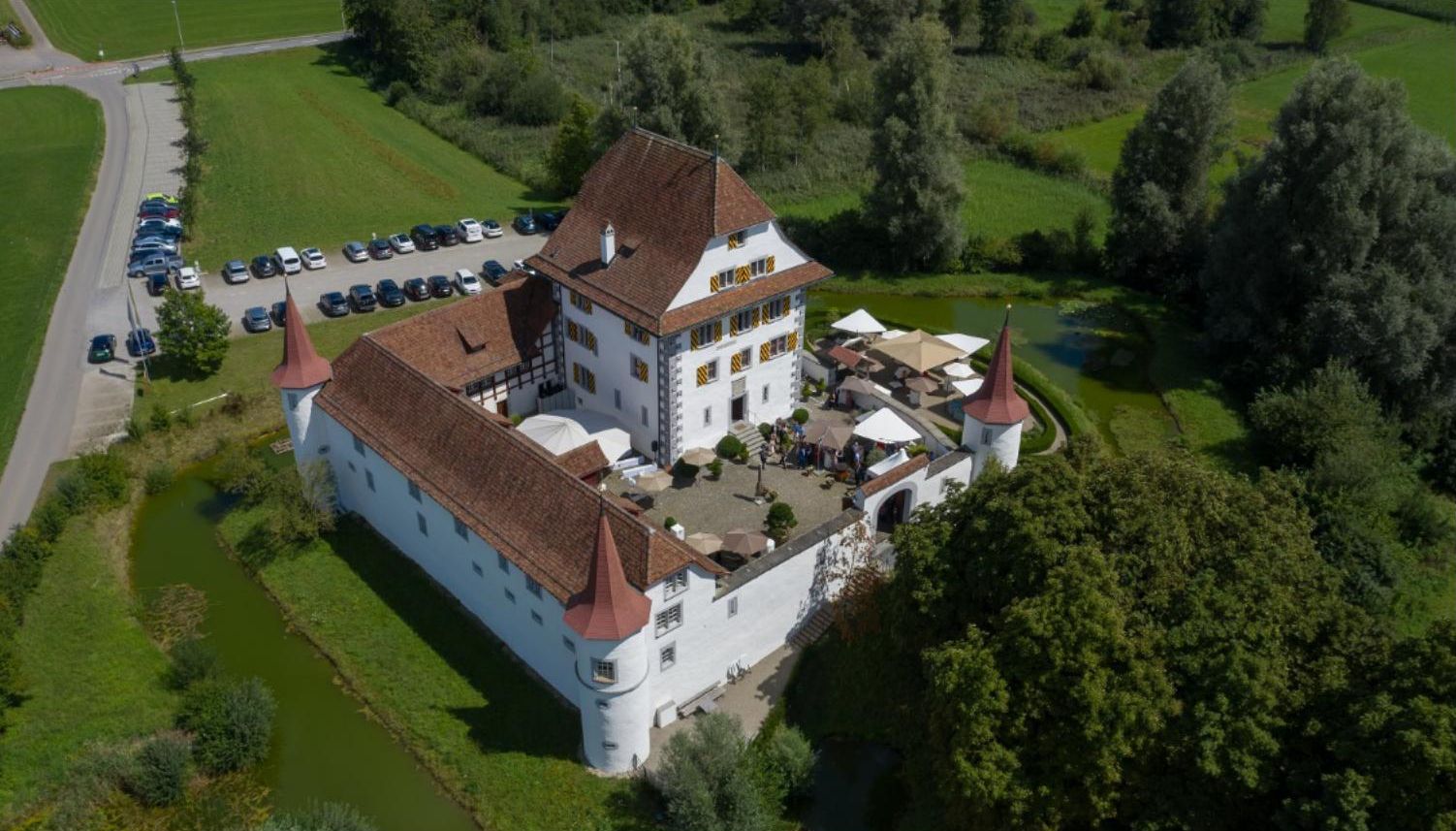
Imprint
Publisher Association of the Stirnimann/Stirnemann Families, Ruswil
Contact Association of the Stirnimann/Stirnemann Families, Moritz Stirnimann, Lindenhausstrasse 4, 6005 Lucerne
Email Verband.stirnimann.stirnemann@gmail.com
Membership Fee unchanged for 2024: CHF 15.00.
Payment slip with QR code (below) or IBAN CH62 0900 0000 6002 3600 0